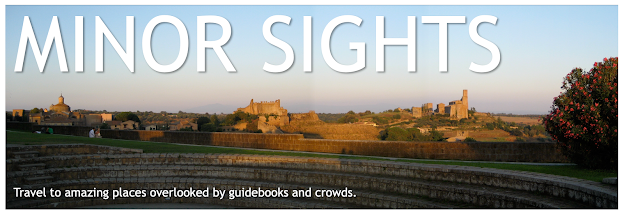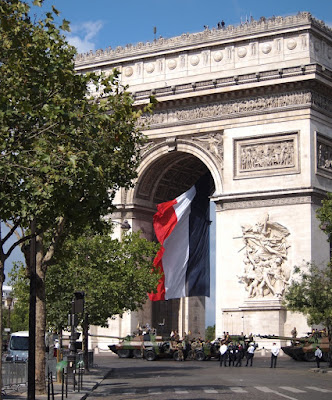What?
A colourful military parade of France's numerous obscure army regiments, one of the main events of the 14th of July National Holiday.
Why visit?
If you're in Paris on the 14th of July, don't miss this.
How often do you get the chance to see soldiers in fancy dress costumes?
In France, once a year, and it's quite a spectacle that's been attracting crowds, including the French President himself, since 1880.
Where?
On the Champs Elysees in the heart of Paris, but only on the 14th of July. Map.
MAKE LOVE NOT war. Yes, but just in case that doesn't work, it's handy to keep an army on hand as a back-up solution, 'cause you never know.
And in spite of the reputation with certain allies (you know who you are) of being a bunch of 'cheese-eating surrender monkeys', the French actually have a strong military tradition whose prominence is unique in Western Europe.
I mean, could you imagine a military parade in Germany to celebrate German Unity Day? Not likely. And while the Brits excel in touristy goose stepping 'Changing of the Guards' ceremonies, sporting quaint rifles, the French unashamedly show off their heavy-duty tanks, rocket launchers, and bombers, whilst cheering on soldiers carrying automatic assault rifles. Nothing quaint about it.
In Europe, only the Russians take their parades more seriously, much to the chagrin of their neighbours, who always get a little nervous when the Russians start moving their tanks about.
On the 14th of July (often referred to in English as 'Bastille Day', but this name is not used in France, where the day is known either as '14 Juillet' or just Fête Nationale) the President presides over a parade of more than 60 different army units, many dressed in colourful costumes that seem rather impractical to wear when fighting; but then, haute couture can often be impractical to wear too...
The tradition goes back 135 years and is considered to be the main event of the 14 July Holiday (although others would nominate the legendary Firemen's Balls- about which more later)
The parade usually starts with jets flying over the Arc de Triomphe in a blaze of blue, blanc, rouge, followed by every possible regiment you can think of, from elite military academies to Special Services all the way to the infamous Foreign Legion. And they each flaunt their own costume, because hey, this is France, so fashion is important.
Most of the squadrons are marching (which makes the street look like a giant catwalk), while others ride armoured vehicles that one would normally hope never to encounter in your hometown- they're a little too reminiscent of Peking 1989 or Prague 1968... fortunately it's a little more light-hearted, and although the soldiers do their utmost to give you their meanest tough man stare, they look serious rather than menacing.
In total more than 7000 troops march along the assembled dignitaries and commoners, taking about 2 hours.
The parade is usually concluded by the Fire Brigade, France's unofficial male sex symbols, and they are generally received with cheers by (mostly female) spectators.
If you can't get enough of hunky men in tight uniforms, be sure to head over to one of the Firemen's Balls (Bals des Sapeurs Pompiers) which are organized on the evening of the 13th and the 14th in fire stations all over the city. There is no more French way to celebrate Quatorze Juillet!
Getting there:
The parade takes place on the Champs Elysees. Many squadrons line up on nearby streets and Boulevards, including Avenue de Friedland, where the Arc de Triomphe picture above was taken.
Useful links:
A full list of participating divisions can be found on Wikipedia.
And to get your party on, head to a nearby Fire Station.
A colourful military parade of France's numerous obscure army regiments, one of the main events of the 14th of July National Holiday.
Why visit?
If you're in Paris on the 14th of July, don't miss this.
How often do you get the chance to see soldiers in fancy dress costumes?
In France, once a year, and it's quite a spectacle that's been attracting crowds, including the French President himself, since 1880.
Where?
On the Champs Elysees in the heart of Paris, but only on the 14th of July. Map.
MAKE LOVE NOT war. Yes, but just in case that doesn't work, it's handy to keep an army on hand as a back-up solution, 'cause you never know.
 |
| Ready to march... |
In Europe, only the Russians take their parades more seriously, much to the chagrin of their neighbours, who always get a little nervous when the Russians start moving their tanks about.
On the 14th of July (often referred to in English as 'Bastille Day', but this name is not used in France, where the day is known either as '14 Juillet' or just Fête Nationale) the President presides over a parade of more than 60 different army units, many dressed in colourful costumes that seem rather impractical to wear when fighting; but then, haute couture can often be impractical to wear too...
The tradition goes back 135 years and is considered to be the main event of the 14 July Holiday (although others would nominate the legendary Firemen's Balls- about which more later)
 |
| Sacre Bleu.... and Blanc and Rouge! |
 |
| The Spahi Regiment looking rather dapper in their massive cloaks. |
 |
| Sailors strutting their stuff. |
 |
| A delegation of the Mexican Heroic Military Academy in 2015. |
 |
| The Pioneers of the First Regiment of the Foreign Legion. Beards and Axes- but not in the mood for any jokes about dwarves! |
 |
| Foreign Legion salutes the flag. |
In total more than 7000 troops march along the assembled dignitaries and commoners, taking about 2 hours.
The parade is usually concluded by the Fire Brigade, France's unofficial male sex symbols, and they are generally received with cheers by (mostly female) spectators.
If you can't get enough of hunky men in tight uniforms, be sure to head over to one of the Firemen's Balls (Bals des Sapeurs Pompiers) which are organized on the evening of the 13th and the 14th in fire stations all over the city. There is no more French way to celebrate Quatorze Juillet!
 |
| This party is on fire! |
Getting there:
The parade takes place on the Champs Elysees. Many squadrons line up on nearby streets and Boulevards, including Avenue de Friedland, where the Arc de Triomphe picture above was taken.
Useful links:
A full list of participating divisions can be found on Wikipedia.
And to get your party on, head to a nearby Fire Station.










Comments
Post a Comment
Have you been here? Or are you planning to go? Either way, we would love to hear about it.